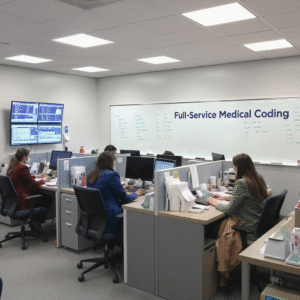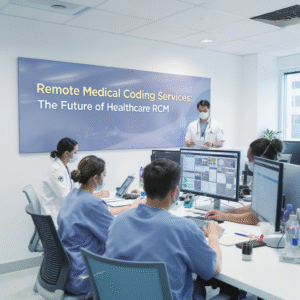Key Performance Indicators (KPIs) for Medical Billing: A Comprehensive Guide to Revenue Cycle Excellence
Medical Billing
Medical Billing
In the complex landscape of healthcare administration, medical billing stands as a critical component that directly impacts an organization’s financial health and operational efficiency. As healthcare costs continue to rise and regulations become increasingly stringent, medical practices and healthcare facilities must leverage data-driven insights to optimize their revenue cycle management. This is where Key Performance Indicators (KPIs) become invaluable tools for measuring, monitoring, and improving medical billing performance.
Medical billing KPIs serve as quantifiable metrics that provide healthcare orga

nizations with clear visibility into their billing processes, identify areas for improvement, and ultimately drive better financial outcomes. By tracking the right metrics consistently, healthcare providers can reduce claim denials, accelerate payment collection, and enhance overall revenue cycle efficiency.
Understanding the Importance of Medical Billing KPIs
The healthcare industry faces unique challenges that make effective billing management crucial for survival and growth. With insurance claim denial rates averaging between 5-10% across the industry, and some specialties experiencing even higher rates, healthcare organizations cannot afford to operate without comprehensive performance monitoring systems.
Medical billing KPIs provide several critical benefits. They offer real-time insights into billing performance, enabling quick identification of bottlenecks and inefficiencies. These metrics help establish benchmarks for performance improvement and facilitate data-driven decision making. Additionally, KPIs support compliance monitoring, ensuring adherence to regulatory requirements and industry standards.
Essential Financial Performance KPIs
Net Collection Rate
The net collection rate represents the percentage of collectible revenue that an organization actually collects. This metric excludes contractual adjustments and focuses on the efficiency of collecting payments from both insurance companies and patients. A healthy net collection rate typically ranges from 95-99%, depending on the specialty and patient demographics.
To calculate the net collection rate, divide total payments received by total charges minus contractual adjustments, then multiply by 100. This KPI provides insight into the overall effectiveness of the revenue cycle and helps identify potential issues in claims processing or follow-up procedures.
Gross Collection Rate
The gross collection rate measures the percentage of total charges collected over a specific period. Unlike the net collection rate, this metric includes all adjustments and write-offs in its calculation. While generally lower than the net collection rate, it provides a broader view of financial performance and helps organizations understand their overall revenue capture efficiency.

Days in Accounts Receivable (AR)
Days in accounts receivable represents the average number of days it takes to collect payment after services are rendered. This critical metric directly impacts cash flow and operational sustainability. The industry benchmark for days in AR varies by specialty but generally ranges from 30-50 days for most practices.
A high days in AR figure may indicate inefficient billing processes, delayed claim submissions, or inadequate follow-up on outstanding accounts. Monitoring this metric helps organizations identify trends and implement corrective measures to improve cash flow.
Bad Debt Rate
The bad debt rate measures the percentage of revenue that becomes uncollectible. This metric helps organizations assess the effectiveness of their patient financial counseling, insurance verification, and collection processes. A low bad debt rate indicates strong front-end processes and effective collection strategies.
Operational Efficiency KPIs
Clean Claim Rate
The clean claim rate represents the percentage of claims that are accepted and processed by payers without requiring corrections or additional information. This metric directly correlates with faster payment processing and reduced administrative costs. Industry benchmarks suggest that a clean claim rate of 90% or higher indicates efficient billing operations.
Improving clean claim rates requires attention to data accuracy, proper coding practices, and thorough claim scrubbing processes before submission. Organizations with high clean claim rates typically experience shorter payment cycles and reduced administrative burden.
Claim Denial Rate
The claim denial rate measures the percentage of submitted claims that are rejected by insurance payers. This critical metric helps identify systemic issues in the billing process, from coding errors to eligibility verification problems. While denial rates vary by specialty, most healthcare organizations should aim for denial rates below 5%.
Tracking denial rates by denial reason, payer, and provider helps organizations identify specific areas for improvement and implement targeted training or process improvements.

Time to Bill
Time to bill measures the average number of days between service delivery and claim submission. Faster billing cycles improve cash flow and reduce the risk of claim rejections due to timely filing limits. Most organizations should aim to submit claims within 1-3 days of service delivery.
Appeal Success Rate
The appeal success rate measures the percentage of denied claims that are successfully overturned upon appeal. This metric helps organizations assess the quality of their initial claim submissions and the effectiveness of their appeal processes. A high appeal success rate may indicate issues with initial claim quality, while a low rate might suggest inadequate appeal procedures.
Patient-Focused KPIs
Patient Satisfaction with Billing
Patient satisfaction with billing processes has become increasingly important as healthcare organizations focus on patient experience. This metric can be measured through surveys, feedback forms, and online reviews. High patient satisfaction with billing typically correlates with clear communication, transparent pricing, and convenient payment options.
Point-of-Service Collection Rate
The point-of-service collection rate measures the percentage of patient financial responsibility collected at the time of service. This metric is particularly important as high-deductible health plans become more common, shifting more financial responsibility to patients. Effective point-of-service collection reduces the need for post-service billing and collection efforts.
Patient Payment Time
Patient payment time measures the average number of days patients take to pay their bills after receiving statements. This metric helps organizations understand patient payment behavior and adjust their billing and collection strategies accordingly. Shorter payment times improve cash flow and reduce collection costs.
Compliance and Quality KPIs
Coding Accuracy Rate
Coding accuracy rate measures the percentage of claims that are coded correctly according to current coding guidelines and regulations. Accurate coding is essential for compliance and optimal reimbursement. Regular coding audits help maintain high accuracy rates and identify training needs.
Compliance Score
Compliance scores assess adherence to regulatory requirements, including HIPAA, Medicare guidelines, and other applicable regulations. This metric helps organizations identify compliance gaps and implement corrective measures to avoid penalties and maintain accreditation.
Technology and Process KPIs
Electronic Claims Submission Rate
The electronic claims submission rate measures the percentage of claims submitted electronically versus paper submissions. Electronic submission typically results in faster processing times and reduced administrative costs. Most organizations should aim for electronic submission rates above 95%.
Automation Rate
The automation rate measures the percentage of billing processes that are automated versus manual. Higher automation rates typically correlate with improved efficiency, reduced errors, and lower operational costs. This metric helps organizations identify opportunities for process improvement and technology investment.
Implementing and Monitoring KPIs
Successful KPI implementation requires careful planning and consistent execution. Organizations should start by selecting a manageable number of KPIs that align with their strategic objectives and operational challenges. It’s essential to establish baseline measurements, set realistic targets, and implement regular monitoring and reporting processes.
Data quality is crucial for meaningful KPI tracking. Organizations must ensure that their data collection processes are accurate, consistent, and timely. Regular data validation and cleansing procedures help maintain data integrity and ensure reliable KPI reporting.
Effective KPI management also requires clear accountability and ownership. Each KPI should have a designated owner responsible for monitoring performance, identifying trends, and implementing improvement initiatives. Regular review meetings help ensure that KPIs remain relevant and actionable.

Best Practices for KPI Success
To maximize the value of medical billing KPIs, organizations should focus on several best practices. First, they should align KPIs with strategic objectives and ensure that metrics support overall organizational goals. Second, they should establish realistic benchmarks based on industry standards and organizational capabilities.
Regular KPI review and adjustment are essential as organizations evolve and improve their processes. What matters most may change over time, and KPI frameworks should be flexible enough to accommodate these changes. Additionally, organizations should invest in training and education to ensure that staff members understand the importance of KPIs and their role in achieving performance targets.
Technology plays a crucial role in effective KPI management. Modern practice management and revenue cycle management systems provide robust reporting capabilities that enable real-time KPI tracking and analysis. Organizations should leverage these tools to automate data collection and reporting wherever possible.
Conclusion
Key Performance Indicators for medical billing serve as essential tools for healthcare organizations seeking to optimize their revenue cycle performance. By tracking the right metrics consistently and taking action based on data-driven insights, healthcare providers can improve their financial outcomes, enhance operational efficiency, and deliver better patient experiences.
The journey toward KPI excellence requires commitment, investment, and continuous improvement. However, organizations that successfully implement comprehensive KPI programs typically see significant improvements in their billing performance, cash flow, and overall financial health. As the healthcare landscape continues to evolve, effective KPI management will become increasingly critical for sustainable success in medical billing operations.
Success in medical billing KPI management ultimately depends on selecting the right metrics, maintaining data quality, establishing clear accountability, and taking consistent action based on performance insights. Organizations that embrace this data-driven approach position themselves for long-term success in an increasingly competitive healthcare environment.



